The reasons for the drying of the tops and whether the potatoes grow after that
It so happens that the potato tops dry up and wither, and the novice summer resident does not attach any importance to this. But experienced vegetable growers know that this is an alarming symptom. It signals the onset of a disease or pest attack, as a result of which the plant may die. It is important to urgently understand the reasons for what is happening in order to take the necessary measures in time and save the harvest. From the article you will also learn where to put potato tops after harvesting potatoes.
The content of the article
Potato flowering period and its features
Potatoes begin to bloom 45-60 days after planting. This is an important stage in the development of a plant. But sometimes it refuses to bloom fully, which portends a possible drying of the tops.
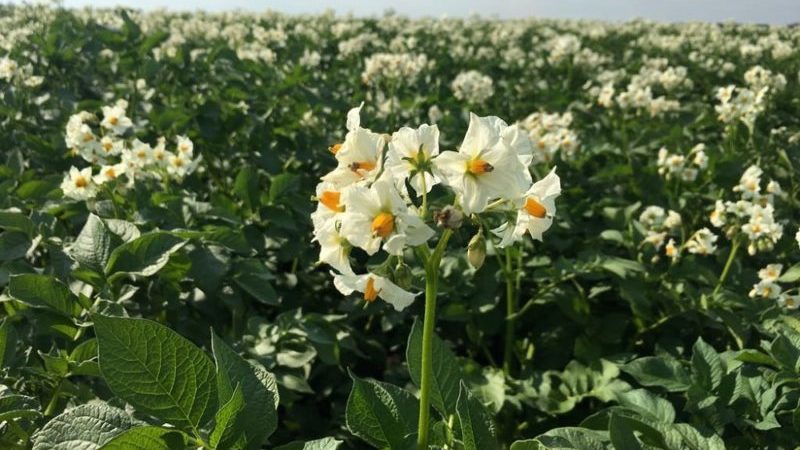
The reasons are different:
- The flower stalks were killed by pests.
- Incorrect planting - non-germinated, low-quality tubers infected with diseases or pests are placed in unheated soil.
- There are not enough nutrients in the earth.
- Hot and dry weather is not suitable for flowering.
- The plant does not bloom due to improper care.
Why does the tops wither and dry
There are many reasons why, long before the start of harvesting, the tops begin to turn yellow and dry.
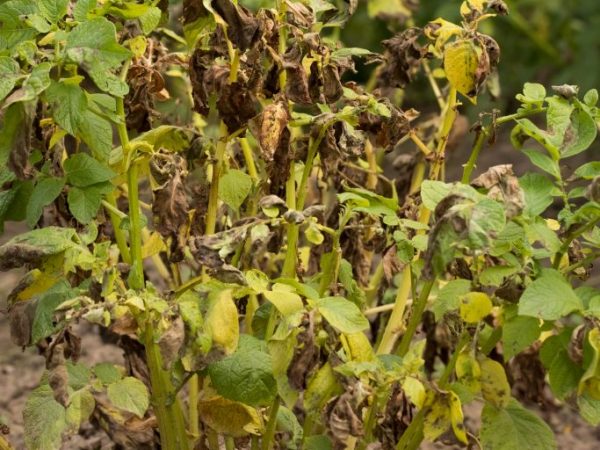
Unfavorable weather conditions
At the beginning of the growing season, when planting tubers, it is necessary to ensure that the soil is warmed up to at least + 10 ° C. In the middle lane, such a temperature regime is achieved by the end of April - beginning of May. The air should warm up to + 15 ° С. In cold soil, the root crop will take too long to germinate and may become sick.
In the future, sharp fluctuations in temperature, night frosts, lack or excess of atmospheric moisture can be the reason that the tops begin to turn yellow and wither ahead of time. A strong, healthy plant can turn black overnight if the temperature drops to minus values or cold dew falls, which often happens, especially in the northern regions.
Frequent and heavy rains can lead to premature drying and blackening of the foliage on the bush. Stagnation of water in the root system blocks air access to them, the plant finds itself in conditions of oxygen starvation and as a result dies.
In hot, dry weather and a lack of rainfall, the plant sheds its leaves, trying to reduce the evaporation of moisture from their surface, and during prolonged drought, the potato remains without leaves.
Diseases
Most often, drying and death of potato tops are associated with manifestations of fungal, viral or bacterial infections.
Fungal
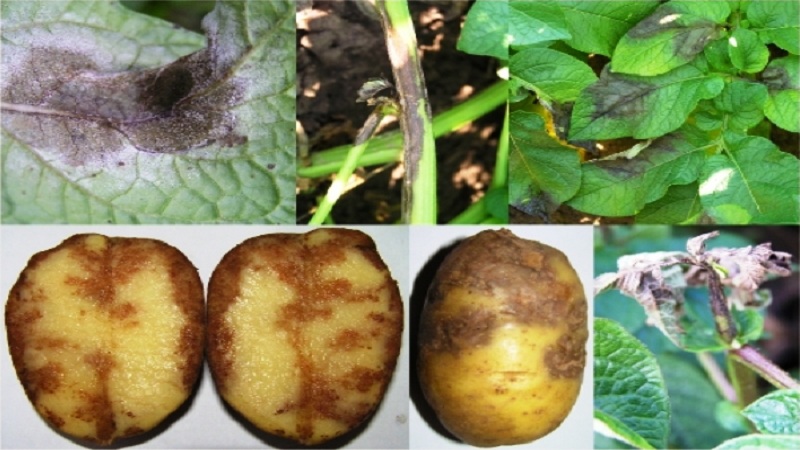
One of the most common fungal diseases in plants is late blight... The leaves become lethargic, extensive brown darkening forms on them, which soon turn black and dry. In the future, tubers are also affected by late blight, as a result, you can lose most of the crop.
Important!When the first signs of late blight appear, the infected tops are immediately mown and burned.
To avoid such a problem, it is important to pay attention to preventive measures:
- Sprout the tubers in the light before planting, which will lead to rotting of the infected and facilitate their culling.
- Do not plant potatoes in an area where the plants show symptoms of late blight. This is especially true for nightshades (tomato and pepper).
- Choose varieties that are resistant to late blight.
- Do not plant potatoes too tightly.
- Weeding, hilling and loosening to saturate the root system with oxygen.
- During the flowering period, treat the plant with copper-containing preparations or "Fitosporin" at a later date.
When small dark spots with a yellow rim appear on the leaves of potatoes, alternaria can be suspected. Large spots cause macrosporiosis. The dangerous fungal disease Fusarium begins with the usual wilting of the upper leaves.
If any signs of illness appear, you can try to save the crop by treating the bushes with Fitosporin. It does not contain hazardous substances and is used at any stage of the growing season.
The most effective method of combating fungal diseases is prophylactic dressing of tubers before planting with Fitosporin or Baktofit preparations.
Viral
Viral infections are among the most dangerous. Among them there are also those that provoke the death of potato tops, for example, various mosaic strains: wrinkled, banded, spotted and speckled.
Although the outward manifestations of the disease are different, in all cases the affected foliage stops the vegetative process several weeks or even months earlier. As a result, the yield loss reaches 30% or more.
Attention! The source of infection can be on the surface of the seed potato or on the body of the insect carrier. To prevent the spread of the disease, the infected plant is removed along with the tubers.
Hot, dry weather can be a prerequisite for the development of the PLRV (leaf rolling) virus, which leads to the death of half of the crop. It will be possible to prevent infection if seed potatoes are soaked in a solution of 1.5% boric acid before planting. For additional protection use drugs "Epin" and "Zircon".
Viral diseases are especially dangerous, because there are no effective means that can protect a plant from them. They can be transmitted through insects and even the gardener's tools.
Bacterial
Blackleg bacterial disease develops immediately after germination. At the same time, the base of the stem rots, the plant lays down, and the leaves turn yellow and curl.
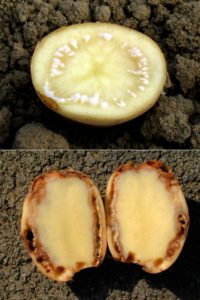
Antibacterial drugs will help fight the disease. Of the folk remedies, the most effective is the treatment of the infected area with a mixture of ash and copper sulfate (for 1 kg of wood ash - 2 tbsp. L. Copper sulfate).
Bacterial brown rot causes drying tops, damage and death of part of the crop. The source of distribution is infected seed potatoes. The disease develops very slowly, manifests itself in the second year, when already during flowering the leaves turn yellow, wrinkle and curl.
For prophylaxis, before planting, it is recommended to treat potatoes with the preparation "Rizoplan". There are no special chemicals to fight the disease during the growing season.
Pests
Colorado beetle - the well-known striped eater of potato tops, which can destroy the crop in a matter of days. As a result, photosynthesis is disrupted, the plant dies, tubers do not form and do not grow.
Larvae are the most dangerous. Adults survive the winter in the ground at a depth of 30 cm and in spring they lay their eggs on the underside of young foliage.
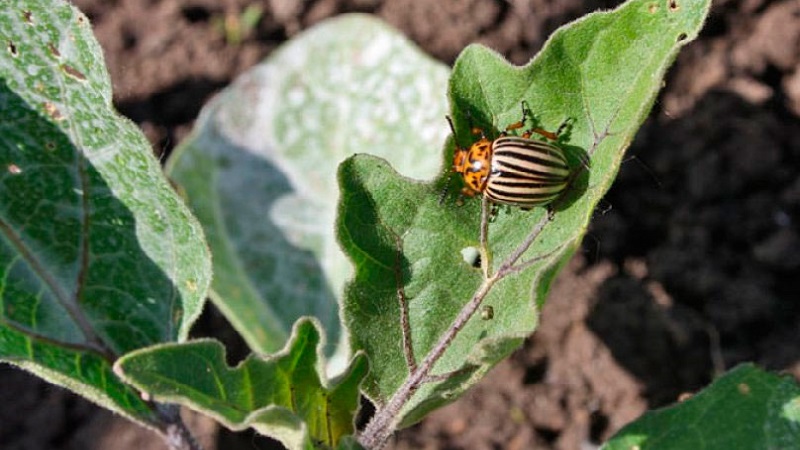
There are a lot of ways to fight, but they are not always effective:
- Opponents of chemical control agents collect larvae and beetles in a container with a strong solution of sodium chloride.
- Plants that repel the pest are planted between the rows of potatoes: dill, beans, calendula, nasturtium and marigolds.
- Spray with infusion of elecampane and celandine.
- Biological agents are used - "Boverin" and "Bitoksibacillin".
- In the case of widespread distribution, the chemicals "Aktara", "Commander", "Iskra" are used.
Nematode worms settle in the root system, and their larvae suck the juices from the leaves. As a result, the tops become covered with black dots, turn yellow and dry, the tubers stop developing.
The click beetle (wireworm), leafhopper, potato flea can also lead to drying of the tops.
Important!It is necessary to remember about the dangers of toxic drugs for humans and not to carry out processing for at least 20 days for harvesting.
Lack of trace elements and poor soil
Potato tops can turn yellow and dry out if there is a shortage of:
- iron - the upper leaves turn yellow;
- magnesium - upper;
- nitrogen, responsible for the development of green mass;
- potassium - the leaves acquire a bronze tint, curl and dry out.
To avoid this, it is necessary to fertilize with microelements, spraying with boron is especially useful. This reduces the plant's susceptibility to disease.
It is not worth overusing fertilizers, this can lead to a decrease in yield. A month before harvesting potatoes, feeding is stopped.
What to do if the tops wither
If wilting occurs at the end of summer, this is a sign of tubers ripening.
When it is still far from harvesting, and the tops are drying and turning yellow, it is necessary to look for the causes of the problem and eliminate them so as not to lose the crop. This is the fight against diseases and pests, plant nutrition with useful microelements.
Does the potato grow after the tops dry
In yellowed and withered leaves, the process of photosynthesis (conversion of solar energy into nutrients for the plant) is impossible, so the growth of tubers stops.
When to dig out potatoes after the tops have dried
In August - September, after the tops have dried, the potatoes stop growing, nutrients accumulate in the tubers, and a thick, durable peel is formed.
The tubers become suitable for long-term storage.
It is interesting:
How to properly trim the tops of potatoes and why you need it
Types of potato diggers for a mini-tractor, principle of operation and selection criteria
Life hacks of experienced farmers: why pick flowers from potatoes and what does it give
What to do with tops, how to use them
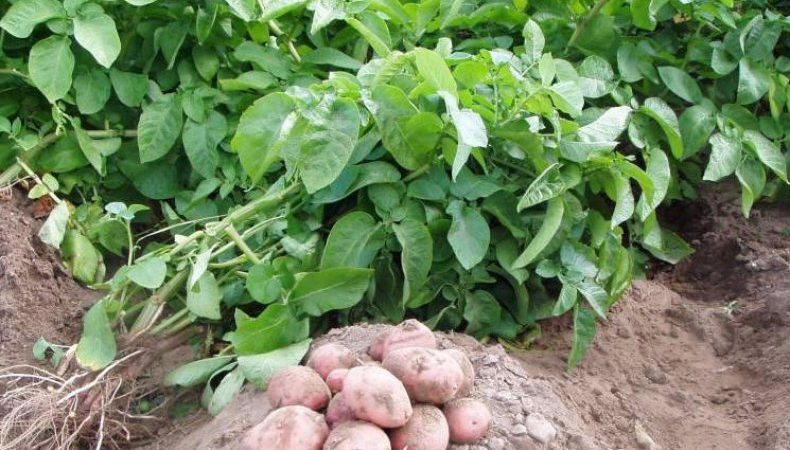
After harvesting, the tops are dried and burned. The resulting ash is used as a fertilizer with a high content of potassium and phosphorus, necessary for any plant.
Attention!Incineration is carried out in designated places in compliance with all fire safety rules.
You can use the tops as compost. For this you need:
- Mow the still green leaves.
- Place in layers in a compost pit.
- Treat each layer with a solution of copper sulfate (2-3 tablespoons per 10 liters of water). This is necessary to destroy harmful microorganisms that may be in the tops.
- Bury the hole, cover with leaves or sawdust.
The compost will only be safe after 3 years. This period is necessary for the termination of the vital activity of the fungi that cause late blight.
The tops are used to protect the trunks of fruit trees and berry bushes from frost. To do this, it is laid in a thick layer around the tree trunk.
The resulting pillow:
- protects the root system;
- serve as a fertilizer;
- prevent weeds from growing and repel pests.
Why do potatoes have high tops, but no tubers?
Before taking action, you need to find out if high tops are a feature of the variety... If not, then all the plant's strength was spent on the development of leaves, and not on the formation of tubers.
This is most often due to excess nitrogen, which promotes the development of greenery at the expense of the crop. Also, the reason is high humidity, insufficient lighting and too close landing.
If the last 3 reasons why potatoes have large tops and no tubers will not be easy to fix, then the harmful effects of nitrogen can be neutralized with superphosphate (100 g of the drug is dissolved in a bucket of water at + 60 ° C). This is enough to process 20 bushes.
Some gardeners, trying to save the crop, mow the overgrown tops as early as possible. This can be done one month after flowering. This procedure will help you get a high-quality harvest.
It is interesting:
Conclusion
There are many reasons for drying and death of potato tops: unfavorable weather conditions, diseases and pests, deficiency of trace elements. Do not let the pathological process take its course.
To get a full harvest of potatoes, it is important to understand the reasons and take the necessary measures: feed the plant or carry out treatment for diseases and pests.